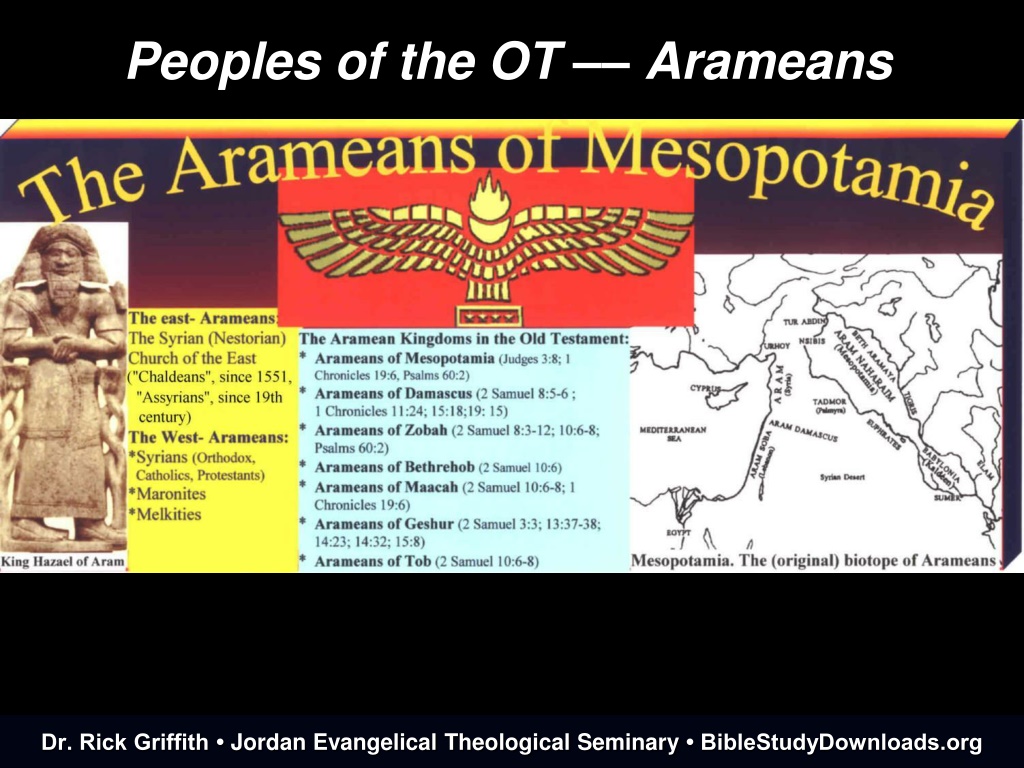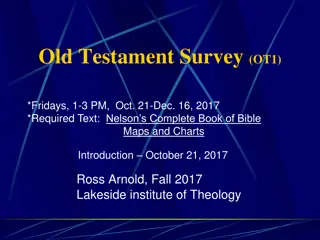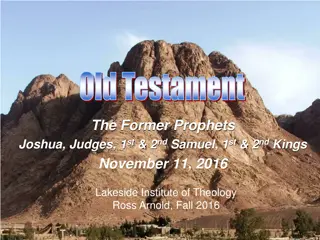Exploring the Arameans of the Old Testament
Uncover the history and contributions of the Arameans in the Old Testament. Learn about their identity, genealogy, geography, and interactions with other civilizations like Israel. Discover the unique aspects of Aramean culture and their presence in Northern Syria, Upper Mesopotamia, and beyond.
Download Presentation

Please find below an Image/Link to download the presentation.
The content on the website is provided AS IS for your information and personal use only. It may not be sold, licensed, or shared on other websites without obtaining consent from the author. Download presentation by click this link. If you encounter any issues during the download, it is possible that the publisher has removed the file from their server.
E N D
Presentation Transcript
Peoples of the OT Arameans Dr. Rick Griffith Jordan Evangelical Theological Seminary BibleStudyDownloads.org
Introduction 121 Who were the Arameans? What were their contributions? What can we learn from them?
Identity Who were they? 121 17 Amulet with Akedah and Daniel in the Lion's Den: Akedah (Sacrifice of Isaac, Genesis 22)
Genealogy 121 17 Descended from Aram (grandson of Nahor). Nahor and Abraham were brothers. Both descended from Shem, the son of Noah. NOAH (Gen. 22:20-24; Deut. 26:5) Japheth Ham Shem Terah Laban and his brother, Bethuel, were Arameans (Gen. 25:20) Abraham was a wandering Aramean (Deut. 26:5). Haran Nahor Abraham Jacob Aram Arameans Israelites
Geography 122 Where did the Arameans Live? Northern Syria and Upper Mesopotamia (1100 - 800 BC) Central and Southern Syria (1000 800 BC) Southern Mesopotamia (approx. 1000 BC)
aramaic 124 Arameans & Israel
Northern Syria & Upper Mesopotamia Crossed by Assyrian Conquerors "I have crossed the Euphrates 28 times, twice in one year " Tiglath-Pileser I (1114-1076 BC) Tiglath-Pileser I and Ashur-Bel-Kala (1073-1056 BC) Ashur-Dan II (934-912 BC) Shalmaneser III (858-824 BC) "INSCRIPTION" No Evidence of Developed Political Centralization
Central & Southern Syria During King David's Reign (ca. 1000 BC) Zobah (an Aramean state), a dominant political power in Southern Syria led by King Hadadezer engaged Israel in battle three times. The Aramean king Hadadezer joined the Ammonites to attack Israel. " The sons of Ammon sent and hired the Syrians of Beth-rehob and the Syrians of Zobah " (2 Sam.10:6). King Hadadezer gathered new troops from Zobah and fought Israel again: " Hadadezer sent and brought out the Syrians " (2 Sam. 10:16).
Civilization There was not a single "Aramean culture" as the various states had their own distinctives. They were not linked into a single political unit, hence, they made few contributions to political structures or practices in the ANE. Aramean art and architecture were also not influential. But their single most important influence was in spreading the Aramaic language.
Aramaic Language Parts of the books of Daniel and Ezra were written in Aramaic (e.g., Dan. 2 7). The West Semitic dialect known as Aramaic became: The official inter-provincial language of the Persian Government. The language of Jesus and the people in the Ancient Near East. The modern day liturgical language of several Eastern churches today.
Impact of Aramaic Aramaic replaced many local languages in ANE, including Hebrew Arameans were the first to write alphabetic letters for long vowel sounds Aramaic dialects are still spoken in a few isolated towns of Syria today
Aramaic Alphabet (Alep-beet) A consonant alphabet with no vowel indication Written from right to left in horizontal lines
The Lord's Prayer in Aramaic Aramaic was the language of the Semitic culture, the language of the Hebrew Patriarchs, and in the older days, the lingua franca of the Fertile Crescent.
Origin of Term "Hebrew" The term "Hebrew" comes from the Aramaic word Abar or Habar, which means "to cross over." This name was given to the Hebrew people simply because Abraham and the people who were with him crossed the river Euphrates and went into Canaan.
Origin of Term "Hebrew" Therefore, they were known by those who lived east of the river Euphrates as Hebrews, that is, "the people across the river." All branches of the great Semitic people had a common speech.
Jonah's Preaching was Understood Fact Finder #1: How could the people of Nineveh have understood the prophet Jonah, had the biblical Hebrew tongue been different from Aramaic?
Names Surviving Today Male Aramaic Names Abbot | Abbott | Antoun | Barclay | Bardo | Bardol | Barley | Barnabas | Barnahy | Bart | Barta | Bartalan | Bartel | Barthelemy | Bartholomaus | Bartholomew | Bartlet | Bartley | Bartol | Bat | Batt | Beartlaidh | Berkley | Berti | Cephas | Ezeklel | Jagur | Jesus | Mar | Mathias | Matthias | Myron | Parlan | Parthalan | Raz | Razi | Raziel | Saul | Shai | Tadeo | Tamas | Tamlane | Teoma | Thaddeus | Thady | Thom | Thomas | Thompsen | Thompson | Tom | Tomas | Tomasso | Tomm | Tommie | Tommy | Zachaeus | Zechariah | Zeke
Names Surviving Today Female Aramaic Names Alisa | Aliza | Anina | Bethani | Bethanie | Bethanney | Bethany | Betheny | Liri | Magdalena | Marit | Marite | Marta | Martha | Marthe | Marti | Martie | Martika | Marty | Martyne | Matti | Mattie | Mekeda | Morta | Omnomonpea | Pat | Patty | Rebecca | Sam | Samanntha | Samantha |Samanthia | Sami | Sammantha | Semantha | Simantha | Symantha | Tabatha | Tabathia | Tabbie | Tabby | Tabitha | Tabithe | Tabytha | Taletha | Talitha | Xaverie | Zurama
Laban the Aramean Spoke Aramaic Aramaic Was Evident Throughout Bible History Jacob spoke Hebrew, while Laban spoke Aramaic: "So Jacob took a stone, and set it up as a pillar. And Jacob said to his kinsmen, 'Gather stones,' and they took stones, and made a heap; and they ate there by the heap. Laban called it Jegar-sahadutha, but Jacob called it Galeed" (Gen. 31:45-47).
Assyrians Understood The Assyrian forces that attacked King Hezekiah of Judah spoke Aramaic: "Then Eliakim the son of Hilkiah, and Shebnah, and Joah, said to the Rabshakeh, 'Pray, speak to your servants in the Aramaic language, for we understand it; do not speak to us in the language of Judah within the hearing of the people who are on the wall'" (2 Kings 18:26)
People in Judah Spoke Aramaic The people of Judah returned from the Babylonian captivity in the Persian era. Those opposing the rebuilding of Jerusalem spoke Aramaic: "Then the people of the land discouraged the people of Judah, and made them afraid to build, and hired counselors against them to frustrate their purpose, all the days of Cyrus king of Persia, even until the reign of Darius king of Persia. And in the reign of Ahasuerus they wrote an accusation against the inhabitants of Judah and Jerusalem. And in the days of Artaxerxes, Bishlam and Mithredath and Tabeel wrote to Artaxerxes king of Persia; the letter was written in Aramaic and translated" (Ezra 4:4-7).
Babylonians Spoke Aramaic The astrologers who served King Nebuchadnezzar spoke to the king in Aramaic. They were unable to reveal the meaning of the king's dream but God revealed the meaning to Daniel: "Then the astrologers answered the king in Aramaic, 'O king, live forever! Tell your servants the dream, and we will interpret it'" (Daniel 2:4).
Writing in Babylon in Aramaic The Writing on the Wall to Belshazzar was in Aramaic: "Then from his presence the hand was sent, and this writing was inscribed. And this is the writing that was inscribed: MENE, MENE, TEKEL, and PARSIN" (Daniel 5:24-25).
Aramaic Names in John's Gospel 1) "Some time later, Jesus went up to Jerusalem for a feast of the Jews. Now there is in Jerusalem near the Sheep Gate a pool, which in Aramaic is called Bethesda and which is surrounded by five covered colonnades" (John 5:1-2).
Aramaic Names in John's Gospel 2) "When Pilate heard this, he brought Jesus out and sat down on the judge's seat at a place known as the Stone Pavement, which in Aramaic is Gabbatha. It was the day of Preparation of Passover Week, about the sixth hour. 'Here is your king,' Pilate said to the Jews. But they shouted, 'Take him away! Take him away! Crucify Him!'" (John 19:13-15).
Aramaic Names in John's Gospel 3) "Finally Pilate handed Him over to them to be crucified. So the soldiers took charge of Jesus. Carrying His own cross, He went out to the place of the Skull, which in Aramaic is called Golgotha. Here they crucified Him, and with him two others one on each side and Jesus in the middle" (John 19:16-18).
Jesus Christ Spoke in Aramaic 1) "He brought him to Jesus. Jesus looked at him, and said, 'So you are Simon the son of John? You shall be called Cephas which means Peter'" (John 1:42). Cephas is Aramaic but Peter is a Greek name.
Jesus Christ Spoke in Aramaic 2) "And He said, 'Abba [the Aramaic word for Father], Father, all things are possible for You; remove this cup from Me; yet not what I will, but what You will'" (Mark 14:36 ).
Jesus Christ Spoke in Aramaic 3) "And at the ninth hour Jesus cried [in Aramaic] with a loud voice, "Eloi, Eloi, lama sabach-thani?" which means, "My God, My God, why hast thou forsaken Me?" (Mark 15:34).
Mary Magdalene Spoke in Aramaic 4) "Jesus said to her, 'Mary.' She turned toward Him and cried out in Aramaic, 'Rabboni!' which means Teacher" (John 20:16).
Sign Above the Cross in Aramaic Fact Finder #2: The sign that was nailed to the cross above Jesus Christ was written in how many languages? What did the sign say? See John 19:19-20.
Sign Above the Cross in Aramaic John 19:19-20 19"Now Pilate wrote a title and put it on the cross. And the writing was: JESUS OF NAZARETH, THE KING OF THE JEWS." 20"Then many of the Jews read this title, for the place where Jesus was crucified was near the city; and it was written in: HEBREW (ARAMAIC), GREEK AND LATIN.
Conclusion The Arameans were not as politically or culturally (as well as militarily) strong as some of the other OT peoples in the Ancient Near East. Their most lasting impact was their language that, via cultural diffusion, they imprinted on the Ancient Middle East societies. The Arameans inhabited the Fertile Crescent in the 14th century, but did not begin seriously influencing the region until three centuries later, when they began to spread into southern Anatolia and northern Arabia, which were Assyrian territories.
Conclusion The Arameans were a military force until about the 9th century, when they fell to the attacking Assyrians. Although the Aramean nation fell, its language did not; Aramaic, which is very similar to Hebrew, was adopted not only by Babylonian Jews as the "Jewish tongue," but also by the well-informed as the language of choice. It was not until Greek emerged several centuries later that Aramaic lost its prestige as the most sophisticated language. Jewish practices are still performed in Aramaic, including the Ketubah (wedding contract), the Get (divorce contract), and the Kaddish (mourner's prayer). Interestingly, much of the Kabbalah (Jewish mysticism) was written in Aramaic. Also, the Talmud was written in a combination of Aramaic and Hebrew.
Conclusion The success of the Aramaic language should not be attributed as merely a "stronger" language than others in the ANE. Perhaps the fact that Aram was a descendant of Shem, Noah's son, would mean that God had preserved the language so that Noah's descendants would be able to know about the Noahic Covenant (flood). This would ensure that, generations later, Noah's encounter with God would not be diluted.
Peoples of the OT - Arameans aramaic Supplements Aramaic amulet
Peoples of the OT - Arameans Central and Southern Syria But King David marched his army northward and defeated King Hadadezer at Helem. " David gathered all Israel together and crossed the Jordan, and came to Helam...". (2 Sam 10:17). Another confrontation between King David and King Hadadezer at Hamath. "David also defeated Hadadezer king of Zobah as far as Hamath, " 1 Chron 18:3 Damascus (key Aramean state) sent troops to fight the Israelites but was defeated by King David (Damascus' first appearance in the Hebrew Bible).
Peoples of the OT - Arameans Central and Southern Syria Aram Damascus: " the Syrians of Damascus came to help Hadadezer, king of Zobah " (2 Sam. 8:5). In the Hebrew Bible, it is called "Aram" Other translations called it "Syria" Aram Damascus is the part of the Aramean world that had the greatest effect on biblical Israel It was also the most powerful state that bordered Israel.
Peoples of the OT - Arameans Central and Southern Syria During King Solomon's reign: Rezon (King Hadadezer's former officer) seized Damascus and it became an independent state. " God also raised up another adversary to him, Rezon ..he gathered men to himself and became leader of a marauding band " (1 Kings 11:23-24). After Solomon died, the rulers of Damascus seized the advantage and established Aram Damascus as a significant presence. "So Ben-haded sent the commanders of his armies against Israel, and conquered " (1 Kings 15:20).
Peoples of the OT - Arameans Central and Southern Syria Aramean King Ben-Hadad attacked the Northern kingdom of Israel and captured a number of important towns: "Now there was war between Asa and Baasha King of Israel Ben-Hadad heeded King Asa, and sent the captains of his armies against the cities of Israel. He attacked Ijon, Dan, Abel Beth Maachah, and all of Chinneroth, with all the land of Naphtali" (1 Kings 15:16-22).
Peoples of the OT - Arameans Central and Southern Syria A series of conflicts between Israel and Aram "Now Ben-Hadad, king of Syria gathered all his forces together; thirty-two kings were with him, with horses and chariots. And he went up and besieged Samaria " (1 Kings 20:1, 22). "So the king of Israel (Ahab) and Jehoshapat the king of Judah went up against Ramoth Gilead" (1 Kings 22:29).
Peoples of the OT - Arameans Central and Southern Syria Aramean King Hazael oppressed Israel all the days of King Jehoahaz: "And Hazael, king of Syria oppressed Israel all the days of Jehoahaz" (2 Kings 13:22).
Peoples of the OT - Arameans Central and Southern Syria Hazael's policy was to expand into Israel: "In those days the LORD began to cut off parts of Israel; and Hazael conquered them in all the territory of Israel from the Jordan eastward: all the land of Gilead Gad, Reuben, and Manasseh from Aroer, which is by the river Arnon, including Gilead and Bashan" (2 Kings 10:32-33). Aram became a significant empire that covered much if not all of Syria and Palestine
Get this presentation for free! OT Backgrounds link at BibleStudyDownloads.org























